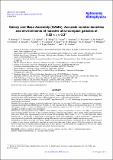Galaxy and Mass Assembly (GAMA) : accurate number densities and environments of massive ultra-compact galaxies at 0.02 < z < 0.3⋆
Abstract
Context. Massive ultra-compact galaxies (MUGs) are common at z = 2−3, but very rare in the nearby Universe. Simulations predict that the few surviving MUGs should reside in galaxy clusters, whose large relative velocities prevent them from merging, thus maintaining their original properties (namely stellar populations, masses, sizes and dynamical state).Aims. Our goal is to obtain a complete census of the MUG population at 0.02 < z < 0.3, determining the number density, population properties and environment.Methods. We have taken advantage of the high-completeness, large-area spectroscopic GAMA survey, complementing it with deeper imaging from the KiDS and VIKING surveys. We find a set of 22 bona-fide MUGs, defined as having high stellar mass (> 8 × 1010 M⊙) and compact size (Re < 2 kpc). An additional set of seven lower-mass objects (6 × 1010 < M⋆/M⊙ < 8 × 1010) are also potential candidates according to typical mass uncertainties.Results. The comoving number density of MUGs at low redshift (z < 0.3) is constrained at (1.0 ± 0.4)×10−6 Mpc−3, consistent with galaxy evolution models. However, we find a mixed distribution of old and young galaxies, with a quarter of the sample representing (old) relics. MUGs have a predominantly early or swollen disk morphology (Sérsic index 1 < n < 2.5) with high stellar surface densities (⟨Σe⟩∼1010 M⊙ Kpc−2). Interestingly, a large fraction feature close companions – at least in projection – suggesting that many (but not all) reside in the central regions of groups. Halo masses show these galaxies inhabit average-mass groups.Conclusions. As MUGs are found to be almost equally distributed among environments of different masses, their relative fraction is higher in more massive overdensities, matching the expectations that some of these galaxies fell in these regions at early times. However, there must be another channel leading some of these galaxies to an abnormally low merger history because our sample shows a number of objects that do not inhabit particularly dense environments.
Citation
Buitrago , F , Ferreras , I , Kelvin , L S , Baldry , I K , Davies , L , Angthopo , J , Khochfar , S , Hopkins , A M , Driver , S P , Brough , S , Sabater , J , Conselice , C J , Liske , J , Holwerda , B W , Bremer , M N , Phillipps , S , López-Sánchez , A R & Graham , A W 2018 , ' Galaxy and Mass Assembly (GAMA) : accurate number densities and environments of massive ultra-compact galaxies at 0.02 < z < 0.3⋆ ' , Astronomy & Astrophysics , vol. 619 , A137 , pp. 1-21 . https://doi.org/10.1051/0004-6361/201833785
Publication
Astronomy & Astrophysics
Status
Peer reviewed
ISSN
0004-6361Type
Journal article
Collections
Items in the St Andrews Research Repository are protected by copyright, with all rights reserved, unless otherwise indicated.
Related items
Showing items related by title, author, creator and subject.
-
SDSS-IV MaNGA: How the stellar populations of passive central galaxies depend on stellar and halo mass
Oyarzún, Grecco A.; Bundy, Kevin; Westfall, Kyle B.; Tinker, Jeremy L.; Belfiore, Francesco; Argudo-Fernández, Maria; Zheng, Zheng; Conroy, Charlie; Masters, Karen L.; Wake, David; Law, David R.; McDermid, Richard M.; Aragón-Salamanca, Alfonso; Parikh, Taniya; Yan, Renbin; Bershady, Matthew; Sánchez, Sebastián F.; Andrews, Brett H.; Fernández-Trincado, José G.; Lane, Richard R.; Bizyaev, D.; Boardman, Nicholas Fraser; Lacerna, Ivan; Brownstein, J. R.; Drory, Niv; Zhang, Kai (2022-07-06) - Journal articleWe analyze spatially resolved and co-added SDSS-IV MaNGA spectra with signal-to-noise ratio ∼100 from 2200 passive central galaxies (z ∼ 0.05) to understand how central galaxy assembly depends on stellar mass (M*) and halo ... -
Secular-and merger-built bulges in barred galaxies
Mendez Abreu, Jairo; Debattista, V. P.; Corsini, E. M.; Aguerri, J. A. L. (2014-12) - Journal articleContext. Historically, galaxy bulges were thought to be single-component objects at the center of galaxies. However, this picture is now questioned since different bulge types with different formation paths, namely classical ... -
Galaxy And Mass Assembly (GAMA) : galaxy close pairs, mergers and the future fate of stellar mass
Robotham, A. S. G.; Driver, S. P.; Davies, L. J. M.; Hopkins, A. M.; Baldry, I. K.; Agius, N. K.; Bauer, A. E.; Bland-Hawthorn, J.; Brough, S.; Brown, M. J. I.; Cluver, M.; De Propris, R.; Drinkwater, M. J.; Holwerda, B. W.; Kelvin, L. S.; Lara-Lopez, M. A.; Liske, J.; Lopez-Sanchez, A. R.; Loveday, J.; Mahajan, S.; McNaught-Roberts, T.; Moffett, A.; Norberg, P.; Obreschkow, D.; Owers, M. S.; Penny, S. J.; Pimbblet, K.; Prescott, M.; Taylor, E. N.; van Kampen, E.; Wilkins, S. M. (2014-11-11) - Journal articleWe use a highly complete subset of the Galaxy And Mass Assembly II (GAMA-II) redshift sample to fully describe the stellar mass dependence of close pairs and mergers between 10(8) and 10(12)M(circle dot). Using the analytic ...

